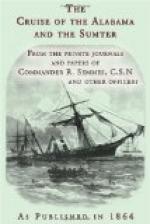2. Since the receipt of the above-mentioned document, the Alabama arrived at this anchorage (the 16th instant), and when Captain Semmes waited on me, I acquainted him with the report, requesting he would inform me if it was true. I was glad to learn from him that it was not so. He frankly explained that the prize Sea Bride in the first place had put into Saldanha Bay through stress of weather, and on being joined there by the Tuscaloosa, both vessels proceeded to Angra Pequena, on the West Coast of Africa, where he subsequently joined them in the Alabama, and there sold the Sea Bride and her cargo to an English subject who resides at Cape Town. The Tuscaloosa had landed some wool at Angra Pequena and received ballast, but, he states, is still in commission as a tender. It will, therefore, be seen how erroneous is the accompanying report. I have no reason to doubt Captain Semmes’ explanation; but he seems to be fully alive to the instructions of Her Majesty’s Government, and appears to be most anxious not to commit any breach of neutrality.
3. The Alabama has returned to this port for coal, some provisions, and to repair her condensing apparatus.
4. From conversation with Captain Semmes, I find that he has been off this Cape for the last five days, and as the Vanderbilt left this on the night of the 11th instant, it is surprising they did not see each other.
The Duke of Newcastle to Sir P. Wodehouse. November 4, 1863.
I have received your despatch of the 19th August last, submitting for my consideration various questions arising out of the proceedings at the Cape of Good Hope of the Confederate vessels Georgia, Alabama, and her reputed tender, the Tuscaloosa.
I will now proceed to convey to you the views of Her Majesty’s Government on these questions.
The capture of the Sea Bride, by the Alabama, is stated to have been effected beyond the distance of three miles from the shore—which distance must be accepted as the limit of territorial jurisdiction, according to the present rule of international law upon that subject. It appears, however, that the prize, very soon after her capture, was brought within the distance of two miles from the shore; and as this is contrary to Her Majesty’s orders, it might have afforded just grounds (if the apology of Captain Semmes for this improper act, which he ascribed to inadvertence, had not been accepted by you) for the interference of the colonial authorities upon the principles which I am about to explain.
With respect to the Alabama herself, it is clear that neither you nor any other authority at the Cape could exercise any jurisdiction over her; and that, whatever may have been her previous history, you were bound to treat her as a ship of war belonging to a belligerent Power.
With regard to the vessel called the Tuscaloosa, I am advised that this vessel did not lose the character of a prize captured by the Alabama, merely because she was, at the time of her being brought within British waters, armed with two small rifled guns, in charge of an officer, and manned with a crew of ten men from the Alabama, and used as a tender to that vessel under the authority of Captain Semmes.




